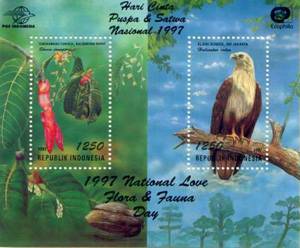SOUTH SUMATRA
- Duku Fruit (Lansium
domesticum)
The tropical fruit Duku has long been known in
the area as a favoured fruit and the trees grow
in almost all regions of the province. People
call it 'duku from Palembang'. The duku trees
grow in Malaya Peninsula, Thailand, Myanmar, the
Philippines, Indonesia and Papua New Guinea. In
the market, the fruit has high economic value.
- Belida Fish (Chitala
lopis)
Is known in this province for its delicous taste.
From this fish local people make special food
called 'pempek' and 'kerupuk' (fish chips).
Besides in Indonesia, this fish can also be found
in Thailand and Myanmar. This water fauna which
can have 87 cm length and 15 kg weight is a
predator. It eats shrimps and small fishes.
|
|
JAKARTA
- Salacca of Condet
(Salacca zalacca)
Condet region in Jakarta is known as producer of
many kinds of fruits, one of which is Salacca.
The Salacca from Condet is popular for its sweet
taste, large size and small seed. This flavoured,
crunchy, snake-scaled palm fruit is prized in the
Indonesian table. Salacca trees grow in bunch,
the fruit come in stem, have dark brown colour
with ordered fins. The leaves resemble long
ribbons and orderly come of stem at the base of
the tree.
- The Brahminy Kite
(Haliastur indus)
Is known lately as the mascot of the 14th
National Sports Week. It has bright chestnut
plumage with white head, neck and breast. It has
perfect flying ability and sharp vision in
hunting its victims such as fish, frogs, snakes
and lizards. Their remaining habitats are the
Thousand Island and Jakarta Bay, where they can
find mangrove forest.
|
|
WEST KALIMANTAN
- Tengkawang Tungkul
(Shorea stenoptera)
Shorea of Tengkawang Tungkul, of the
Dipterocarpaceae family, has oil-bearing nuts,
locally known as Tengkawang oil. The tree blooms
and bears single-seeded fruit at the age of 8 to
10 years. After months since its inception, the
fruit becomes ripe and its skin gets hard. The
frozen oils from shorea nuts is used in the
chocolate, wax, soap, and cosmetics manufacture.
- Helmeted Hornbill
(Rhinoplax vigil)
Or Tajai from West Kalimantan, the largest of its
kind and regarded by the Dayaks, the native of
Kalimantan, as a sacred bird. It has large head
and bill and striking plumage. The solid casque
at the top of its head is the source of the
precious carved hornbill ivory - where it derives
its name. The bird has dark brown coloration with
white belly and dark red bill. The length of its
tail can reach twice as long as its body. The
bird can be found in Sumatra and Kalimantan up to
the height 1,500 m above sea level. The hornbill's
manic call is one of the most memorable and
thrilling sounds of the Kalimantan jungle. It
eats fruits, especially banyan seeds, palm fruits,
insects, rats and small birds.
|
|
WEST NUSA
TENGGARA
- Ajan Kelicung (Diospyros
macrophylla)
This Black Wood or Ebony is favoured for its
sweet smell. The tree grows in lowland mingling
with other trees, and has no pure population. Its
trunk is straight with 35 cm diameter. The tree
blooms in July and October.
- Rusa or Timor
Deer (Cervus timorensis)
It has small body, but long horns and tail. The
colour of its body is yellowish dark brown. Rusa
Deed are not easy to see because they are shy and
nocturnal. Local people used to hunt the animal.
They eat the meat, make mats from the skin and
use the horns for house decoration. Deer live at
savannahs in Lombok and Sumbawa Islands and can
also be found in Sulawesi and Irian Jaya.
|
|
SOUTHEAST
SULAWESI
- Fibre Orchid (Diplocaulobium
utile)
Grows on old tree trunks, its roots grow in bunch.
It has long, pointed, single leaves. The flower
come out of the fold between the leaves and the
stalks. In addition to the beauty of its flowers,
the roots can also be used for plaited
handicrafts.
- Anoa (Bubalus
depressicornis)
The world's smallest buffalo, is endemic to
Sulawesi and one of the best known Sulawesi
mammals. The small-size body, only 90 cm tall at
the shoulder and half the height of its mainland
relative, gives it other name, the dwarf buffalo.
Its body and colour are like buffalo, but its
size is like a goat. The animal wanders the
lowland and mountain forests, feeding on trunk-borne
fruits, herbs, grasses, wild ginger leaves, and
search the seaside grassland at night for salt-water.
Its short and sharp horns are straight to the
back, and can inflict fatal injuries on humans.
Today this fauna is one of the protected species.
|
|
A. STAMP
- Design :
- Duku Fruit & Belida
Fish (South Sumatra)
- Salacca of Condet &
Brahminy Kite (Jakarta)
- Tengkawang Tungkul &
Ivory/Helmeted Hornbill (West Kalimantan)
- Ajan Kelicung & Timor
Deer (West Nusa Tenggara)
- Fibre Orchid & Lowland
Anoa (Southeast Sulawesi)
- Date of issue : 05 November 1997
- Quantity : 1,000,000 sets
- Paper : white unwatermarked
- Gum : PVA
- Printing process : combination of
offset and Rotogravure
- Size : 25,31 x 41,06 mm
- Perforation : 13,50 x 12,75
- Sheet composition : 20 (10x2)
|
|
B. FIRST DAY COVER
- FDC + Stamps (2 pcs)
- FDC + S/S (2pcs)
|
|
C. SOUVENIR SHEET
- Design :
- Tengkawang Tungkul &
Brahminy Kite
- Quantity : 125,000 pcs
|
 |
| D. STAMP PACK
|
|
